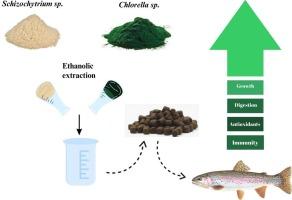Chlorella sp.和 Schizochytrium sp.提取物对虹鳟鱼(Oncorhynchus mykiss)生长指数、身体成分和基因表达谱的影响。
IF 1.8
3区 生物学
Q4 BIOCHEMISTRY & MOLECULAR BIOLOGY
Comparative Biochemistry and Physiology B-Biochemistry & Molecular Biology
Pub Date : 2024-11-16
DOI:10.1016/j.cbpb.2024.111047
引用次数: 0
摘要
本研究评估了膳食小球藻和裂殖小球藻提取物对虹鳟鱼(Oncorhynchus mykiss)生长性能、饲料利用率、身体成分以及与生长、消化、抗氧化防御和免疫反应相关的基因表达的影响。总共 180 尾鱼(平均体重为 8.92 ± 0.04 克)被随机分配到 12 个玻璃纤维鱼缸(400 升,每个鱼缸 15 尾鱼,每个处理 3 个重复)中。鱼被分为四个饮食组,每组 60 天:0 %(对照组)、0.5 % 小球藻提取物(CH)、0.5 % 裂殖子提取物(SC)以及 0.25 % 小球藻和 0.25 % 裂殖子的组合(CH + SC)。试验结束时,CH + SC 组鱼的最终体重(FW)为 27.06 ± 0.28 克,明显高于其他组(P<0.05)。本文章由计算机程序翻译,如有差异,请以英文原文为准。

Effects of Chlorella sp. and Schizochytrium sp. extracts on growth indices, body composition, and gene expression profiles in rainbow trout (Oncorhynchus mykiss)
This study assessed the impact of dietary Chlorella sp. and Schizochytrium sp. extracts on growth performance, feed utilization, body composition, and gene expression related to growth, digestion, antioxidant defense, and immune response in rainbow trout (Oncorhynchus mykiss). A total of 180 fish (average weight 8.92 ± 0.04 g) were randomly distributed into 12 fiberglass tanks (400 L, 15 fish per tank, three replicates per treatment). Fish were divided into four dietary groups for 60 days: 0 % (Control), 0.5 % Chlorella sp. extract (CH), 0.5 % Schizochytrium sp. extract (SC), and a combined 0.25 % Chlorella sp. and 0.25 % Schizochytrium sp. (CH + SC). At trial end, fish in the CH + SC group had a final weight (FW) of 27.06 ± 0.28 g, significantly higher than other groups (P < 0.05), with improved growth parameters (P < 0.05). While body composition showed no differences in moisture, lipid, or ash content, crude protein was significantly higher in CH + SC (P < 0.05). Gene expression analysis showed upregulation of the growth hormone GH-I gene in the CH + SC group (P < 0.05). Genes related to digestive enzymes (trypsin, lipase, amylase) were also upregulated in all microalgae groups, with the highest levels in CH + SC (P < 0.05). Additionally, antioxidant genes (SOD, CAT, GPx) and immune-related genes (LYZII, TNF-α, IL-1β) showed elevated expression in CH + SC (P < 0.05). This study demonstrated that a diet containing Chlorella sp. and Schizochytrium sp. extracts supports growth, enhances nutrient utilization, and upregulates genes related to antioxidant and immune function in rainbow trout. Further research is recommended to assess functional immune responses and enzyme activities to confirm these physiological effects.
求助全文
通过发布文献求助,成功后即可免费获取论文全文。
去求助
来源期刊
CiteScore
4.60
自引率
4.50%
发文量
77
审稿时长
22 days
期刊介绍:
Comparative Biochemistry & Physiology (CBP) publishes papers in comparative, environmental and evolutionary physiology.
Part B: Biochemical and Molecular Biology (CBPB), focuses on biochemical physiology, primarily bioenergetics/energy metabolism, cell biology, cellular stress responses, enzymology, intermediary metabolism, macromolecular structure and function, gene regulation, evolutionary genetics. Most studies focus on biochemical or molecular analyses that have clear ramifications for physiological processes.

 求助内容:
求助内容: 应助结果提醒方式:
应助结果提醒方式:


